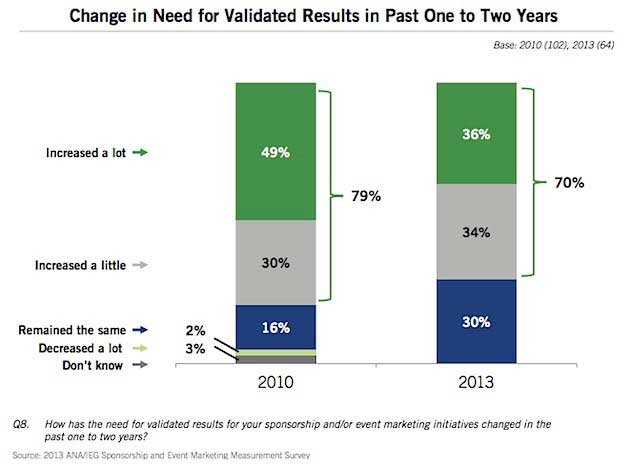Most marketers (62%) report being at least somewhat satisfied with their ability to measure the return on investment (ROI) of sponsorship and event marketing initiatives, according to a recent report from the Association of National Advertisers.
However, nearly a quarter (23%) say they are not very satisfied with their ability to measure ROI, and 15% percent say they are not at all satisfied.
Similarly, most marketers (68%) report being at least somewhat satisfied with their ability to measure the return on objectives (ROO) of sponsorship and event marketing initiatives, but a substantial percentage (32%) are dissatisfied.

Below, additional key findings from the report, which was based on data from a survey of 78 client-side marketers from companies involved in sponsorship or event marketing, or both. Sponsorship was defined in the survey as "a fee paid to a property (typically sports, entertainment, nonprofit event, or organization) in return for access to the exploitable commercial potential" and event marketing was defined as "the use of a live experience to create active engagements between a brand and its constituents."
Measurement Trends
- Less than half of marketers have a standardized process for sponsorship/event marketing measurement.
- 25% do not gather, analyze, and use data in sponsorship/event marketing decision-making.
- Only half attempt to isolate the impact for sponsorship/event activity versus other concurrent marketing initiatives.
- 60% of respondents now have a dedicated budget for sponsorship/event marketing measurement, up from 40% in 2010.
- 70% say the need to validate results from sponsorship/event marketing initiatives has increased in the past two years.

Common Metrics
The most common metrics used to measure ROI and ROO of sponsorship/event marketing initiatives are the amount of media exposure generated (used by 70% of respondents) and social media buzz (also 70%).

Useful Metrics
Marketers say the most valuable metrics for measuring the effectiveness of sponsorship/event marketing initiatives are product/service sales (86%), amount of media exposure generated (85%), and increased brand awareness (84%).

About the research: The report was based on data from an online survey of 78 client-side marketers from companies involved in sponsorship and/or event marketing initiatives. The survey was conducted in May and June 2013.




